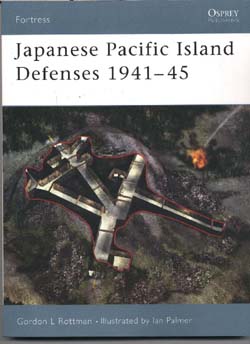 Japanese Pacific Island Defenses 1941-45 Japanese Pacific Island Defenses 1941-45
Fortress 1
By Gordon L. Rottman
Illustrated by Ian Palmer
Osprey Publishing Ltd, 2003
ISBN 1-84176-428-0
64 Pages, Softbound Here’s the first of Osprey’s new series, intended to cover the design, technology and history of key fortresses, strategic positions and defensive systems. This one deals with Japan’s fortified island positions in a very comprehensive way. It begins with a look at Japanese defensive doctrine, which according to the 1938 regulations required passive defense until a relief force arrived. The reality of island combat meant that what actually happened was a kind of passive/active defense, hoping to stop the enemy on the landing beaches but, if this didn’t work, counter-attacking fiercely in a war of attrition to bleed him as much as possible. Attention then turns to the building of the defenses – how they were laid out, the weapons available and their effect on planned layouts, and of course on the building materials and their uses. All this is quite fascinating, and there’s much more to it than snipers in the tops of palm trees and the occasional foxhole or bunker. The Japanese used a very well-defined system with interlocking fields of fire for the various weapons from mortars and machine guns to fairly heavy artillery, though this was the theory and practice didn’t always allow it to be followed. The final section of the book uses Bougainville, Tarawa and Makin as typical examples of Japanese island defenses. The whole work is excellently illustrated with photographs, sketches and plans showing all kinds of positions from individual foxholes to substantial bunkers and cave complexes. Even examples of Japanese barbed-wire entanglements and of their warning signs for minefields, booby traps etc are included! The colour plates are just as good, and show things ranging from the layout of an anti-aircraft gun position to a portable steel machinegun pillbox. Good maps and birds’-eye views complete the mixture. This is a great book for anyone wanting to know just how hard the Japanese islands were to crack, and why US forces took such heavy casualties when assaulting them. It is an essential reference for modellers of the Pacific island-hopping campaign – get your scenic base right, whether it shows a single Japanese soldier in his carefully-built foxhole or an American tank firing point-blank at a pillbox! And speaking of tanks, one photograph shows a Japanese dummy tank carved from solid rock as a decoy – how’s that for a diorama idea? Very highly recommended.
| 








|